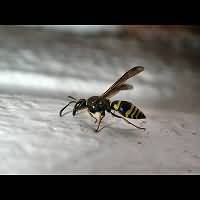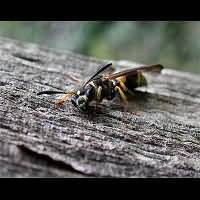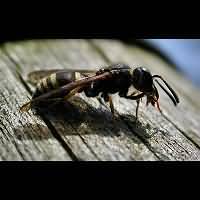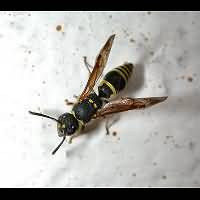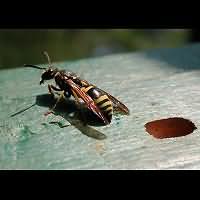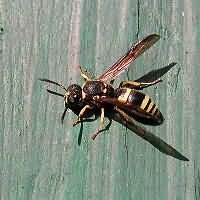Ancistrocerus parietum, a Mason Wasp
The Mason Wasps, genus Ancistrocerus, are all very similar. The basic color is black, covered with yellow lines and other yellow markings. The Mason Wasps all have a very thin connection between the thorax and the abdomen. The next segments are also rather thin, but increase in size. There are well over 12 Ancistrocerus species in Britain and they are very difficult to identify indeed. It is rather certain the animal on this page belongs to the Ancistrocerus parietum group, consisting of Ancistrocerus parietum, A. gazella and A. quadratus. Of these species A. parietum is most common in Holland, while probably A. gazella is most common in Britain. It is virtually impossible to tell the species apart by looking at photographs. The animals are about 1cm in size. Females vary from 10 to 13mm, males are slightly smaller and reach a bodily length of 8 to 11mm.
In spring time, usually by mid-April, the female appears and starts looking for a good place to build a nest. That may be a stem of reet or a hole in a tree used by a beetle to exit. But man made holes in wood are also accepted happily. The wider the hole the bigger the cells in the nest are. Bigger cells produce females, smaller cells males. Usually in one hole two cells are being made. Each cell is stuffed with 2 to 4 sedated caterpillars of moths. The egg is put on top of them and the cell is sealed off. To seal a cell a kind of fine loamy mortal is used, which the animal makes herself by chewing on clay. After hatching the larvae grow very fast indeed. That is the reason Ancistrocerus parietum has two broods a year. That is also the reason it is on the wing for a very long time and may be seen from April to the beginning of October. Being busy as she is, the female attracts a lot of attention. One of them is the beautiful, but very lazy Common Cuckoo Wasp. She keeps an eye on the Mason Wasp. And by the time the Mason Wasp is about to seal off a cell, the Cuckoo Wasp quickly deposits her egg on top of the Mason Wasp's. The cuckoo's egg hatches earlier and the first thing its larva does is eating the Mason Wasp's egg. Then it feeds on the caterpillars so neatly collected by the Mason Wasp.
Of the similar Ancistrocerus species, both A. parietum and A. gazella are very common in Britain.
In the past Mason Wasps were considered to be closely related to the Potter Wasps and they are still often referred to as such.
The Mason Wasps, genus Ancistrocerus, are all very similar. The basic color is black, covered with yellow lines and other yellow markings. The Mason Wasps all have a very thin connection between the thorax and the abdomen. The next segments are also rather thin, but increase in size. There are well over 12 Ancistrocerus species in Britain and they are very difficult to identify indeed. It is rather certain the animal on this page belongs to the Ancistrocerus parietum group, consisting of Ancistrocerus parietum, A. gazella and A. quadratus. Of these species A. parietum is most common in Holland, while probably A. gazella is most common in Britain. It is virtually impossible to tell the species apart by looking at photographs. The animals are about 1cm in size. Females vary from 10 to 13mm, males are slightly smaller and reach a bodily length of 8 to 11mm.
In spring time, usually by mid-April, the female appears and starts looking for a good place to build a nest. That may be a stem of reet or a hole in a tree used by a beetle to exit. But man made holes in wood are also accepted happily. The wider the hole the bigger the cells in the nest are. Bigger cells produce females, smaller cells males. Usually in one hole two cells are being made. Each cell is stuffed with 2 to 4 sedated caterpillars of moths. The egg is put on top of them and the cell is sealed off. To seal a cell a kind of fine loamy mortal is used, which the animal makes herself by chewing on clay. After hatching the larvae grow very fast indeed. That is the reason Ancistrocerus parietum has two broods a year. That is also the reason it is on the wing for a very long time and may be seen from April to the beginning of October. Being busy as she is, the female attracts a lot of attention. One of them is the beautiful, but very lazy Common Cuckoo Wasp. She keeps an eye on the Mason Wasp. And by the time the Mason Wasp is about to seal off a cell, the Cuckoo Wasp quickly deposits her egg on top of the Mason Wasp's. The cuckoo's egg hatches earlier and the first thing its larva does is eating the Mason Wasp's egg. Then it feeds on the caterpillars so neatly collected by the Mason Wasp.
Of the similar Ancistrocerus species, both A. parietum and A. gazella are very common in Britain.
In the past Mason Wasps were considered to be closely related to the Potter Wasps and they are still often referred to as such.

